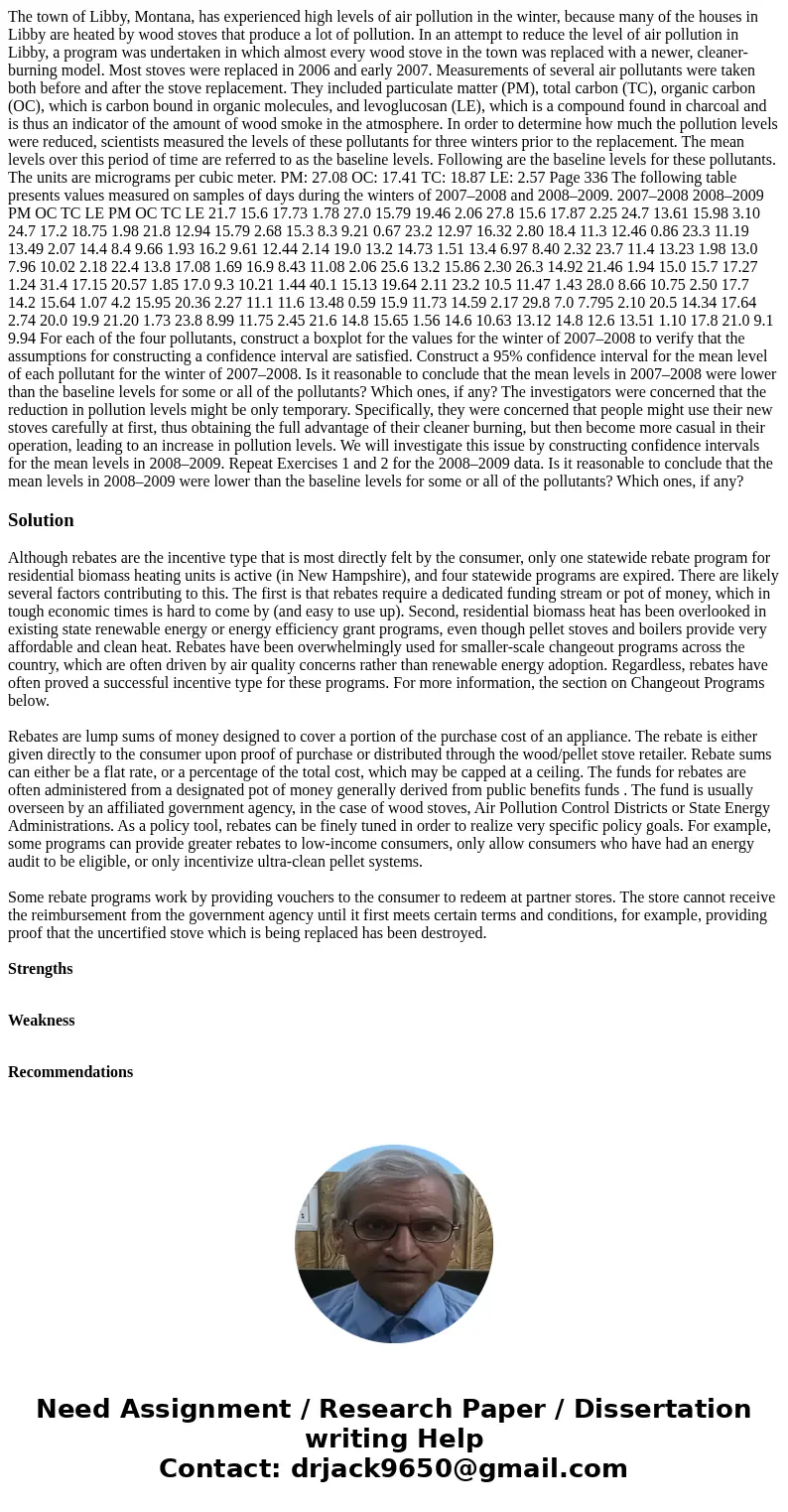The town of Libby Montana has experienced high levels of air
The town of Libby, Montana, has experienced high levels of air pollution in the winter, because many of the houses in Libby are heated by wood stoves that produce a lot of pollution. In an attempt to reduce the level of air pollution in Libby, a program was undertaken in which almost every wood stove in the town was replaced with a newer, cleaner-burning model. Most stoves were replaced in 2006 and early 2007. Measurements of several air pollutants were taken both before and after the stove replacement. They included particulate matter (PM), total carbon (TC), organic carbon (OC), which is carbon bound in organic molecules, and levoglucosan (LE), which is a compound found in charcoal and is thus an indicator of the amount of wood smoke in the atmosphere. In order to determine how much the pollution levels were reduced, scientists measured the levels of these pollutants for three winters prior to the replacement. The mean levels over this period of time are referred to as the baseline levels. Following are the baseline levels for these pollutants. The units are micrograms per cubic meter. PM: 27.08 OC: 17.41 TC: 18.87 LE: 2.57 Page 336 The following table presents values measured on samples of days during the winters of 2007–2008 and 2008–2009. 2007–2008 2008–2009 PM OC TC LE PM OC TC LE 21.7 15.6 17.73 1.78 27.0 15.79 19.46 2.06 27.8 15.6 17.87 2.25 24.7 13.61 15.98 3.10 24.7 17.2 18.75 1.98 21.8 12.94 15.79 2.68 15.3 8.3 9.21 0.67 23.2 12.97 16.32 2.80 18.4 11.3 12.46 0.86 23.3 11.19 13.49 2.07 14.4 8.4 9.66 1.93 16.2 9.61 12.44 2.14 19.0 13.2 14.73 1.51 13.4 6.97 8.40 2.32 23.7 11.4 13.23 1.98 13.0 7.96 10.02 2.18 22.4 13.8 17.08 1.69 16.9 8.43 11.08 2.06 25.6 13.2 15.86 2.30 26.3 14.92 21.46 1.94 15.0 15.7 17.27 1.24 31.4 17.15 20.57 1.85 17.0 9.3 10.21 1.44 40.1 15.13 19.64 2.11 23.2 10.5 11.47 1.43 28.0 8.66 10.75 2.50 17.7 14.2 15.64 1.07 4.2 15.95 20.36 2.27 11.1 11.6 13.48 0.59 15.9 11.73 14.59 2.17 29.8 7.0 7.795 2.10 20.5 14.34 17.64 2.74 20.0 19.9 21.20 1.73 23.8 8.99 11.75 2.45 21.6 14.8 15.65 1.56 14.6 10.63 13.12 14.8 12.6 13.51 1.10 17.8 21.0 9.1 9.94 For each of the four pollutants, construct a boxplot for the values for the winter of 2007–2008 to verify that the assumptions for constructing a confidence interval are satisfied. Construct a 95% confidence interval for the mean level of each pollutant for the winter of 2007–2008. Is it reasonable to conclude that the mean levels in 2007–2008 were lower than the baseline levels for some or all of the pollutants? Which ones, if any? The investigators were concerned that the reduction in pollution levels might be only temporary. Specifically, they were concerned that people might use their new stoves carefully at first, thus obtaining the full advantage of their cleaner burning, but then become more casual in their operation, leading to an increase in pollution levels. We will investigate this issue by constructing confidence intervals for the mean levels in 2008–2009. Repeat Exercises 1 and 2 for the 2008–2009 data. Is it reasonable to conclude that the mean levels in 2008–2009 were lower than the baseline levels for some or all of the pollutants? Which ones, if any?
Solution
Although rebates are the incentive type that is most directly felt by the consumer, only one statewide rebate program for residential biomass heating units is active (in New Hampshire), and four statewide programs are expired. There are likely several factors contributing to this. The first is that rebates require a dedicated funding stream or pot of money, which in tough economic times is hard to come by (and easy to use up). Second, residential biomass heat has been overlooked in existing state renewable energy or energy efficiency grant programs, even though pellet stoves and boilers provide very affordable and clean heat. Rebates have been overwhelmingly used for smaller-scale changeout programs across the country, which are often driven by air quality concerns rather than renewable energy adoption. Regardless, rebates have often proved a successful incentive type for these programs. For more information, the section on Changeout Programs below.
Rebates are lump sums of money designed to cover a portion of the purchase cost of an appliance. The rebate is either given directly to the consumer upon proof of purchase or distributed through the wood/pellet stove retailer. Rebate sums can either be a flat rate, or a percentage of the total cost, which may be capped at a ceiling. The funds for rebates are often administered from a designated pot of money generally derived from public benefits funds . The fund is usually overseen by an affiliated government agency, in the case of wood stoves, Air Pollution Control Districts or State Energy Administrations. As a policy tool, rebates can be finely tuned in order to realize very specific policy goals. For example, some programs can provide greater rebates to low-income consumers, only allow consumers who have had an energy audit to be eligible, or only incentivize ultra-clean pellet systems.
Some rebate programs work by providing vouchers to the consumer to redeem at partner stores. The store cannot receive the reimbursement from the government agency until it first meets certain terms and conditions, for example, providing proof that the uncertified stove which is being replaced has been destroyed.
Strengths
Weakness
Recommendations

 Homework Sourse
Homework Sourse